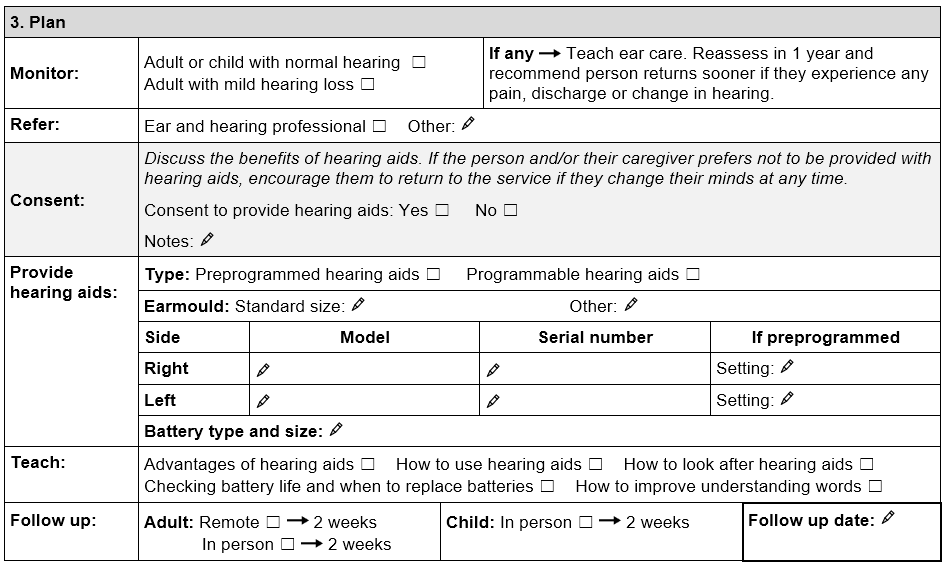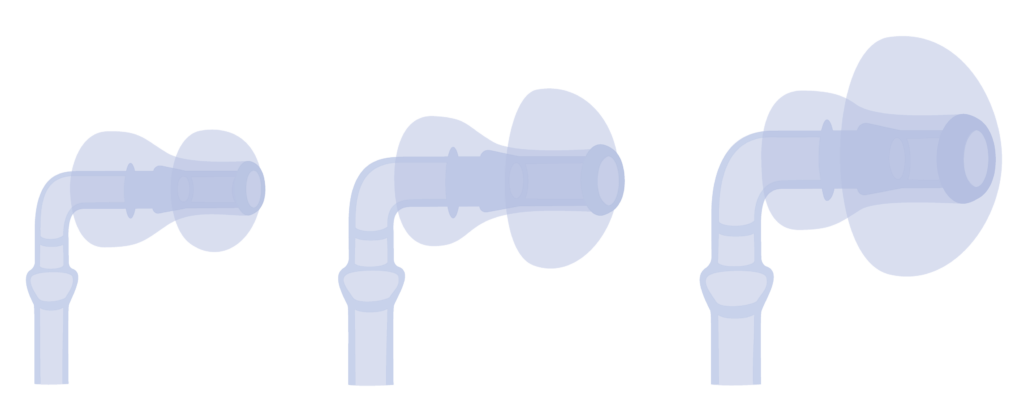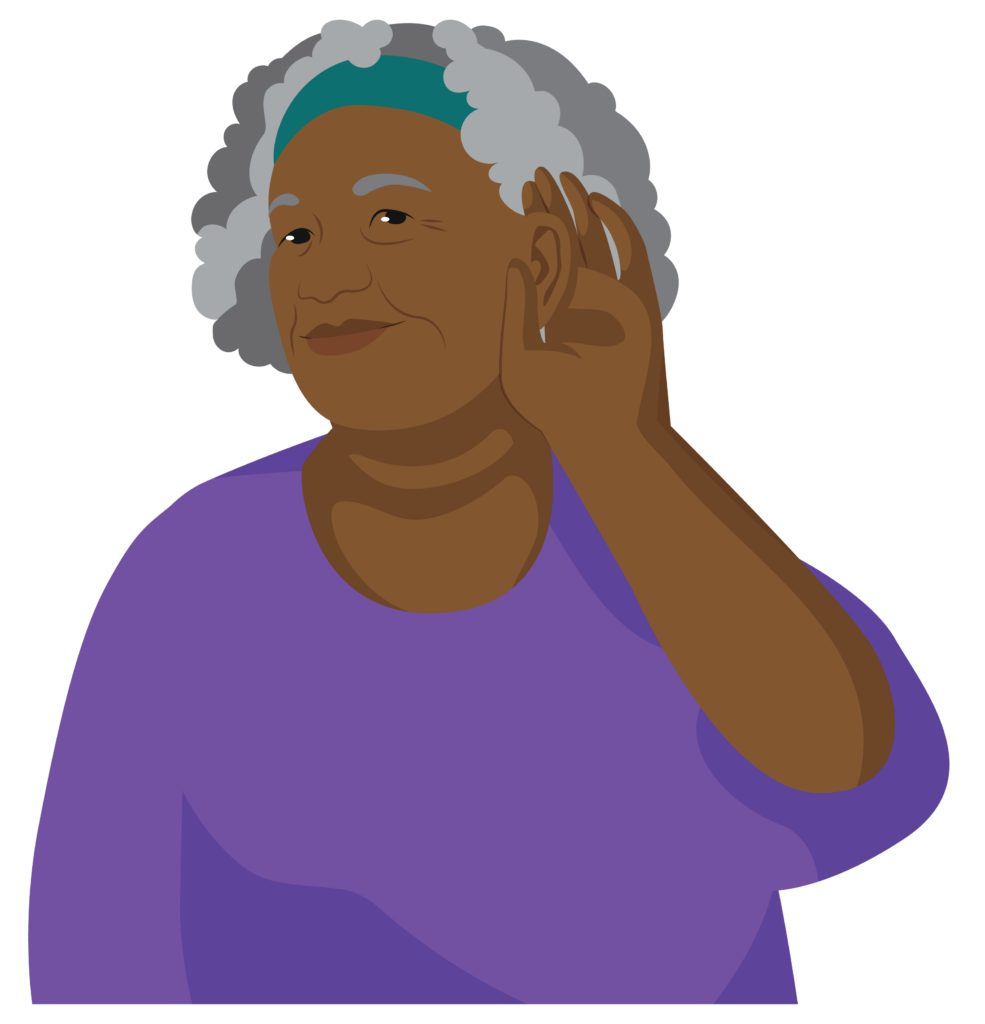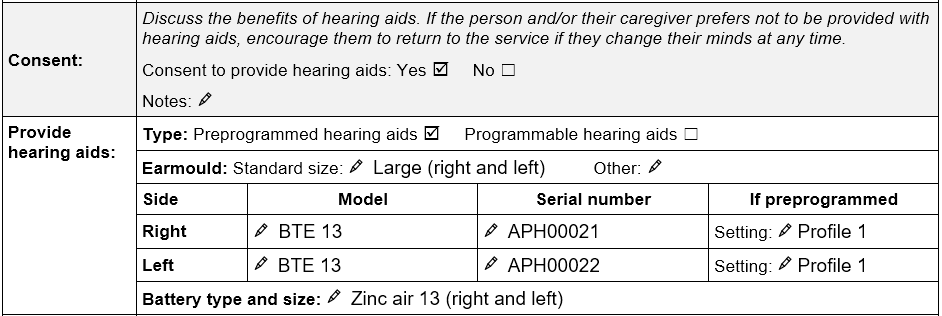After the assessment interview, make a plan with the person. The plan might include:
- 监督听证会
- 转介
- 提供助听器
- Teaching the person how to use their hearing aids safely
- 预约复诊。

教学
You will learn more about fitting hearing aids, teaching, and follow up later in the module.
监测听证会
You should monitor:
- Adults with normal hearing to mild hearing loss
- Children with normal hearing.
Teach person tips for ear care including:
- Avoid putting anything inside your ear
- 避免在脏水中游泳
- 在嘈杂环境中使用耳塞。
Plan follow up in one year to retest hearing. Encourage the person to return sooner if they experience ear pain, discharge or a change in hearing.
教学
Read more about ear care and tips for healthy ears.
认识佩德罗

佩德罗今年 45 岁,在政府办公室工作。他使用电动轮椅。
Pedro notices he is not hearing very well when he is on the phone.
He visits his health clinic. The health worker completes an ear health screen. When looking inside his ear with an otoscope they find that Pedro’s ear is blocked with ear wax.
After having his ear wax removed, the health worker does a hearing test. Pedro’s hearing is normal.
The health worker explains to Pedro that he should return in one year to monitor his hearing or book an earlier appointment if he experiences any change in his hearing.
参考
Some people require more specialist assessment by an ear and hearing professional.
不为以下人员提供助听器
- Adults with profound hearing loss
- 重度至极重度听力损失儿童
- People with more than 15 dB difference between right and left ear.
With their permission refer to an ear and hearing professional.
If you are not confident about the hearing test result, discuss with your mentor and refer to an ear and hearing professional.
提示
People with some types of severe hearing loss benefit from hearing aids, while others may not. Follow up is important to check how much the person is benefitting. Refer to an ear and hearing professional if needed.
同意书
Some people will benefit from hearing aids. However, a person may need time to think about whether they want hearing aids.
Explain the potential benefits of hearing aids and offer the opportunity to experience using them before deciding.
If the person prefers not to be provided with hearing aids, encourage them to return to the service if they change their mind at any time.
Record if the person gives consent to provide hearing aids.
提供助听器
First select the type of hearing aid:
- Preprogrammed for adults or
- Programmable for children.
教学
Programmable hearing aids are suitable for adults. On TAP, if an adult requires programmable hearing aids refer to ear and hearing professional.
耳模
Record the size of a standard earmould that fits comfortably in the person’s ear.
The earmould should not be:
- Too loose as it will cause feedback (whistling)
- Too tight as it may cause pain.

助听器
Record details of both hearing aids. Include the model of hearing aid and the serial numbers. This information is important if the hearing aid needs to be repaired.
For preprogrammed hearing aids, record the selected setting. This is useful if the person accidentally changes the setting.
提示
Check packaging and user manual for serial numbers.
Serial numbers may be found on the body of the hearing aid or in the battery compartment.
电池
A hearing aid battery needs to be replaced regularly.
Record the type and size of hearing aid battery. Different types and sizes have different coloured labels.

教授如何使用
For people to get the most benefit from hearing aids, explain:
- 助听器的优点
- 如何使用和保养助听器
- 如何检查电池寿命以及何时更换电池
- 如何加深对单词的理解。
教学
更多详情,请参阅第四课 "如何使用助听器"。
随访
People need time to adjust to using hearing aids. Advice on simple problem solving can help.
It is important to follow up within two weeks to discuss how the person is getting on.
教学
Learn more in Lesson five about hearing aid follow up and problem solving.
教学
You are now going to practice making a plan.
问题

还记得马利卡吗?
Malicka is 70 years old and a grandmother. She had a hearing test. The results for both her right and left ears show moderately severe hearing loss.
1. What type of hearing aid would you select for Malicka?
选择一个。
Preprogrammed is correct!
Malicka is an adult. Start by offering her preprogrammed hearing aids for both ears.
The large earmould fits Malicka’s ears comfortably. You record the details for each hearing aid in the form:

2. Would you recommend monitoring Malicka in one year?
选择一个。
没有是正确的!
Malicka has moderately severe hearing loss and requires hearing aids. She should have regular follow up instead of yearly monitoring.
3. What would you teach Malicka?
请选择所有适用的选项。
全部正确!
Malicka is receiving hearing aids for the first time. She needs to know how she will benefit from using hearing aids and how to care for her ears and hearing. It is important to know how to use and look after hearing aids and when to change the battery.
Tips for improving understanding words are useful for Malicka and for friends and family when communicating with her.